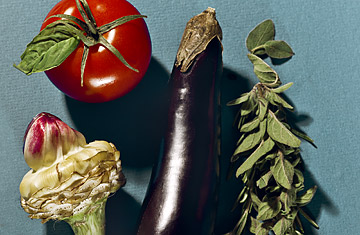
Fresh herbs and veggies aren't just tasty: they're lifesavers
In the fall of 1957, a Minnesota doctor named Ancel Keys traveled from Naples to the southern Italian town of Nicotera. The road was long and dusty, winding for hours into the mountainous toe of the Italian boot. But the trip was worth it. Keys, a physiologist who had spent World War II developing combat food rations, was searching for the answer to one of the great questions of healthy living: Why did heart attacks plague some groups of people (say, Minnesota businessmen) while leaving others (southern Italian farmers, for instance) nearly untouched?
Keys spent his stay in Nicotera measuring body-fat and cholesterol levels, gathering the first data for a global comparison of eating habits that enshrined the Mediterranean diet as the gold standard for a healthy menu. In subsequent visits, Keys and his colleagues weighed the villagers' meals and recorded their contents, showing up unannounced to ensure that what the locals were eating when the scientists arrived was what they normally ate. "Without asking permission, they would open the door and walk into the kitchen," recalls Pasquale Barbalace, 76, a resident of Nicotera who participated in the study as a young man.
The unusual methods helped yield remarkable results. Compared with people in other countries, those in Italy who followed a diet rich in vegetables, legumes and olive oil were 30% to 40% less likely to suffer heart disease than those who consumed heavy quantities of red meat, milk and cheese.
Keys' findings spread fast, but as I discovered when I visited Nicotera last year, the Mediterranean diet could be slipping away. Fifty years of rising incomes, globalization and rapidly changing lifestyles have introduced unhealthy foods to a once healthy place, triggering an obesity epidemic that rivals that of the U.S. "The diet is in crisis," says Barbalace, who runs the Observatory of the Mediterranean Diet, a historical and preservation society in Nicotera. "Today, we eat like Americans."
Indeed, Keys might not recognize where he was if he burst into the typical Nicoteran kitchen today. Gone are the whole-wheat bread baked in a wood-fire stove, the beans slow-cooked in a clay amphora and garnished with herbs picked from the fields that morning. Also absent are the frequent servings of fresh vegetables, dried fruits and nuts. There's still plenty of olive oil, but with it come large quantities of whole milk, cheese, eggs and meat, not to mention junk food.
The Mediterranean diet, it turns out, was a product of poverty. The farmers who trudged into the fields led lives of exertion. Their diet was healthy, but it was a menu of privation. "There was misery," says Alfonso Melchi, 70, a truck driver from Nicotera who participated in the 1957 survey. As cheap, plentiful food became available, morning markets gave way to grocery stores, and carefully husbanded calories were replaced by cheese-covered dishes and slabs of beef.
